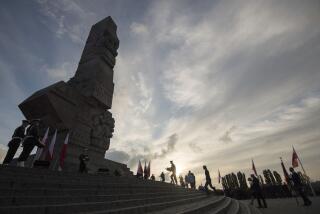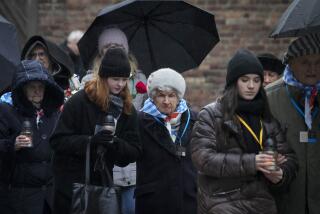E. Germans Gather to Remember Victims of Stalinist Prison Camp
SACHSENHAUSEN, East Germany — Gerna Friedrich clutched a faded photograph Saturday, hoping someone would recognize her long-dead father.
She was one of the hundreds of survivors and relatives who gathered to remember the Germans--some of them Nazis--who died in the Soviet-run Sachsenhausen prison camp after World War II.
During the Third Reich, Sachsenhausen was a notorious Nazi concentration camp. But after the war, it was used as a prison by the Stalinist-era Soviet secret police.
The Soviets imprisoned tens of thousands of suspected Nazi criminals or Germans opposed to the postwar Soviet occupation, and thousands of the internees died. The Soviet zone later became East Germany.
Friedrich, 70, said her father served in the Nazi police force during the war. The Soviets arrested him in 1945, and she never saw him again.
“We hope somebody here will have seen him,” she said. “We are trying to find out about him from other prisoners.”
Such a search would have been impossible a year ago when Communist authorities still ruled East Germany. Speaking about the Soviet crimes of the Stalinist era was taboo.
But since the Berlin Wall crumbled, East Germans have been examining the most brutal period in their postwar history, covered over for decades by Communist propaganda.
Guenther Agde, a former Sachsenhausen inmate, came up with the idea of erecting a monument to the victims of Stalinism at the camp, located 21 miles north of Berlin.
There was already a large museum devoted to resistance movements against Hitler as well as many books and leaflets about the camp, where about 100,000 people died after it was set up in 1936.
But only a small new brochure, printed after last fall’s revolution swept the East German Communist leaders from power, mentions the camp’s history as a Soviet prison from 1945 to 1950.
More to Read
Sign up for Essential California
The most important California stories and recommendations in your inbox every morning.
You may occasionally receive promotional content from the Los Angeles Times.










